Amish Cash Secrets That’ll Make You Think Twice About Your Useless Junk!
Secret to Bulk Bargains

With families averaging seven to eight children, Amish households don’t dabble in single-item shopping. Bulk buying makes sense—flour, sugar, and oats are stocked up by the sack, ready for countless family meals. Buying in bulk lowers costs, minimizes trips to the store, and keeps pantry shelves well-prepped.
While staples come in bulk, smaller items like fabric or tools are bought retail, fitting specific needs without excess. This shopping style means less packaging waste and big savings over time, proving that stocking up is savvy. By avoiding constant smaller purchases trips, Amish families cut down on costs and time, showing how simplicity in shopping leads to savings.
Secrets of Simple Living
Centuries ago, a group of Swiss-German Christians split from the mainstream, choosing a lifestyle that shuns excess and embraces simplicity. Known for their peaceful ways and strict traditions, the Amish communities remain famously “closed.” Now, what does that mean? It means living separately from modern society, focusing on tight-knit community life and minimal outside influence.
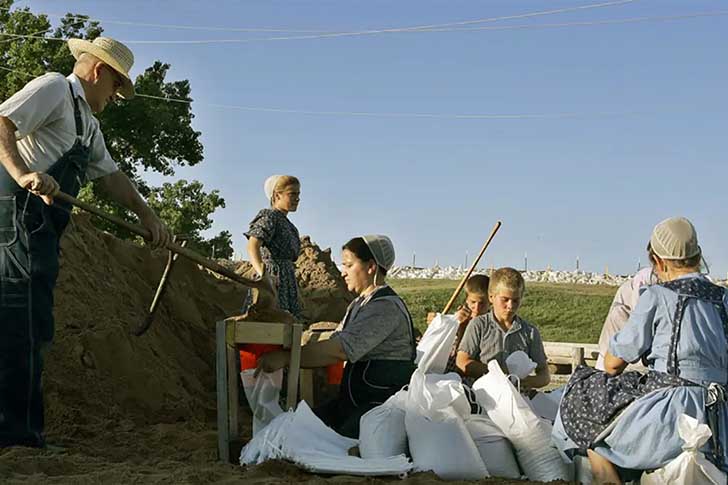
Their way of life might sound restrictive, but it comes with unexpected perks—like a knack for serious money-saving. By avoiding costly trends, sharing resources, and sticking to essentials, they prove that simplicity doesn’t mean deprivation. While many buy new, they’ve perfected make-do-and-mend, which keeps clutter and costs at bay.
Why No Wires Here?
Unplugged living is a weird choice rooted in “Gelassenheit,” the Amish belief in humility and yielding to a higher will. By steering clear of electricity, they dodge modern life distractions while keeping grounded in simplicity. That doesn’t mean living without comfort, though. Kerosene lamps, wood stoves, and gas-powered appliances keep life humming along, minus the electric bill shock.
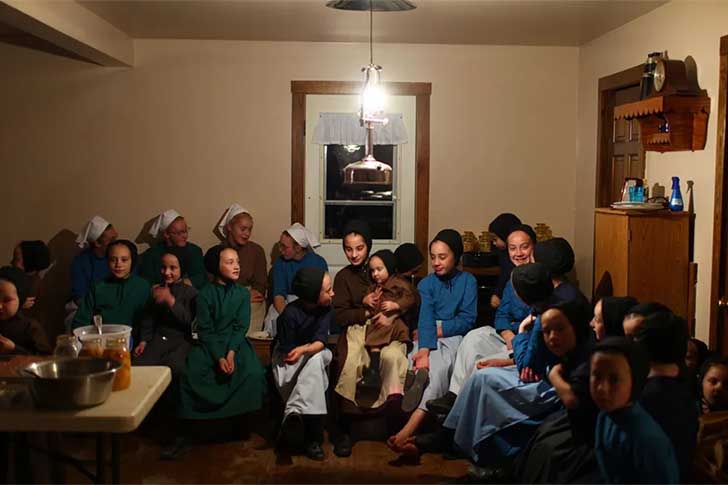
When exceptions arise, like in certain work environments, electricity use is considered but heavily monitored. This intentional lifestyle reduces monthly bills and shows the power of mindful choices. Ultimately, staying unplugged means far more than saving a few dollars—it’s a statement of commitment to simpler values.
Is Facial Hair a Sacred Code?
Keeping it traditional, Amish men grow beards to show maturity and marital status. The mustache once symbolized military association, something the peace-loving Amish firmly avoid. So, while beards are celebrated, mustaches are given a hard pass. Unmarried men remain clean-shaven, but once they tie the knot, the beard becomes an outward expression of commitment and respect.

No trendy grooming techniques here; these beards grow wild and free, emphasizing humility over fashion. Trimming for neatness is fine, but shaping it to look stylish would miss the point. In this culture, a beard isn’t simply facial hair—it’s a badge of faith, tradition, and an unexpected money-saver at the barbershop.
Exploring Freedom in Tradition
Rumspringa—the Amish’s version of a teenage test drive in the “real” world—offers youth a taste of freedom before committing to their faith. Kicking off around 16, it’s a period when young Amish explore outside their tight-knit community, experimenting with modern life thrills they’ve only heard about.

From driving cars to trying out tech gadgets or mingling with non-Amish friends, it’s a crash course in choices. While it’s no full-blown rebellion, this window into mainstream culture provides perspective on life beyond horse-drawn buggies and farm chores. Ultimately, many choose to return, reaffirming their commitment to their roots. Rumspringa is about understanding before embracing the Amish way.
Life Lessons Over Long Lectures
Skipping high school might seem drastic, but for the Amish, an eighth-grade education does the job. Their schooling focuses on practical skills—think arithmetic, reading, and the basics of writing—all essential for running a farm or a family business. Higher education isn’t necessary, as they prioritize hands-on learning over theory, seeing it as the best preparation for their community-focused life.

Young teachers who graduated from the same system often teach lessons in small, one-room schoolhouses. This approach keeps costs low while instilling resourcefulness and self-sufficiency. There’s no spending on tuition when life offers real-world training needed. Here, financial wisdom comes naturally—no student loans are required.
No Frills, All Heart Weddings
Forget designer gowns and towering wedding cakes; Amish weddings focus on simplicity and meaning. Couples tie the knot in November or December, after the harvest, with the community joining in. Requirements include church membership, parental blessings, and a handmade dress (sans sparkles). No DJs, floral extravagance, or costly venues here.

Ceremonies happen in a family home, with a homemade feast following. Friends and family prepare food, saving on catering costs, while decorations are minimal, usually handcrafted by the community. Weddings make the financial benefits of simplicity obvious: no excessive frills, simply a meaningful celebration. There’s zero debt to kick off married life—only genuine community support.
No Exotic Honeymoon Trips
Exotic getaways and luxury resorts don’t cut it for Amish honeymoons. After the wedding, newlyweds spend time visiting family and friends within the community, enjoying a low-cost, relationship-focused honeymoon. No need for hotel bookings or airfare—just meaningful bonding time close to home. If they don’t have a house, they live with family, sharing space and saving on housing expenses.

This practical setup means couples start married life without hefty bills or housing stress. By skipping lavish expenses, Amish newlyweds enjoy a frugal yet fulfilling start, showing that family support and community can replace costly indulgences. It results in a smooth, debt-free transition into marriage about love, not luxury.
Teamwork Makes the Barn Work
Building a barn in Amish culture is teamwork at its finest. Known as “barn raising,” this involves the community pitching in to complete the structure in a single day. Friends, family, and neighbors contribute labor, tools, and expertise, transforming a massive project into a budget-friendly endeavor.

No pricey contractors or labor fees here—the main “expense” is lunch for the crew. This collaborative event is efficient and strengthens community bonds, creating a structure built with goodwill and zero debt. Indeed, when neighbors unite with a shared goal, the biggest jobs get done affordably. This proves that community spirit is a builder’s best budget hack.
Old-School Life’s Health Benefits
While many rely on high-tech health trends, the Amish stick to the basics: fresh food, constant activity, and enough rest. Their daily routine involves manual farm labor, bypassing gyms but logging hours of physical work, which helps explain those low obesity rates. Studies show they enjoy longer lifespans and lower cancer risks.
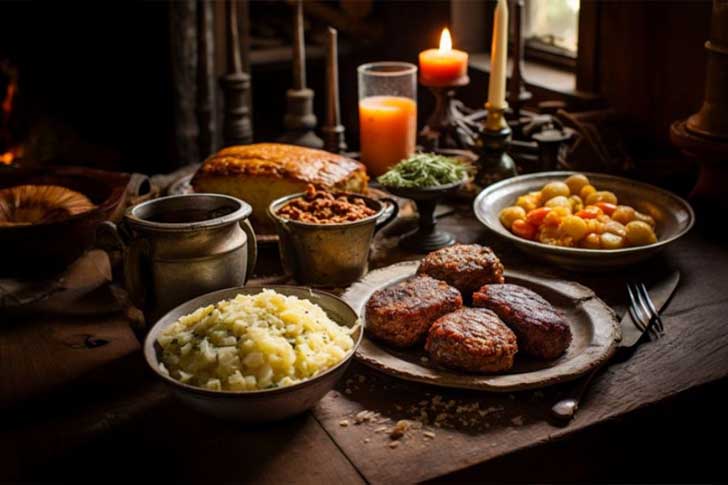
This results from homegrown, chemical-free diets and limited exposure to pollution. Without processed foods or smoking, their lifestyle remains health-conscious. With over 30% less cancer and lower obesity rates, the Amish approach displays how simplicity fosters wellness. Skipping additives and sticking to active days work wonders, making longevity a natural byproduct of their lifestyle.
Three Languages, One Simple Life
With an impressive knack for languages, the Amish community speaks three: Pennsylvania Dutch, English, and High German. Pennsylvania Dutch, their everyday language, comes from their German ancestry, adding a cultural flavor to daily life. High German appears in church, bringing a touch of tradition and solemnity. English, however, is the bridge to the outside world.

It’s handy for business and necessary interactions beyond the community. This multilingual ability is practical, deepens their cultural ties, and keeps their heritage alive. Speaking three languages sharpens communication skills, giving them a subtle edge in understanding their world and ours. It’s proof that simplicity and linguistic savvy go hand in hand.
Life Under the Ordnung
The Ordnung isn’t written in a fancy book, yet it’s the core rulebook of Amish life. Passed down through generations, it’s a set of unwritten guidelines covering everything from dress codes to technology use. Rooted in community values, the rule book shapes what’s allowed, guiding Amish life without endless rules on paper.

Kids start absorbing these guidelines when they are young, picking up expectations by watching their elders. Stray too far from the Ordnung, and consequences await, from gentle correction to temporary shunning. It’s about unity and a shared way of life. This approach keeps life simple and traditions alive, offering a unique structure that values community over an individual whim.
Life on the Edge of Meidung
Breaking the Ordnung, those guiding rules of Amish life, doesn’t go unnoticed. Consequences include Meidung, or shunning, where the community avoids the rule-breaker—even family members. Not meant to punish harshly, it’s a gentle, communal nudge toward repentance and restoring unity. If someone repeatedly resists, excommunication steps in, officially cutting them off from church membership and community life.

These decisions aren’t made casually; leaders approach excommunication carefully, hoping for change before taking that route. For the Amish, Meidung and ex-communication help preserve shared values and the community’s harmony. It’s a system that prioritizes belonging and restoration, where rules mean a shared commitment to the collective good.
Budget-Friendly Dress Code
Amish fashion sticks to simple guidelines, making cutting costs a breeze. Men wear dark trousers, suspenders, and broad-brimmed hats, while women don long, solid-colored dresses with aprons and caps. Flashy fabrics or trendy styles? Not a chance. Stitching follows modest designs, and jewelry is off-limits—too flashy for their taste.

With no seasonal wardrobe changes or statement pieces, clothes stay functional, durable, and affordable. Instead of chasing trends, they prioritize quality and longevity. This wardrobe approach inspires a refreshing lesson in saving: fewer, well-made basics can replace endless purchases. When everyone dresses similarly, there’s no fashion pressure, only savings that come with a classic, timeless look.
How Sharing Keeps Costs Down
Life in Amish communities thrives on the “sharing is caring” belief, making social events lively and budget-friendly. Men gather for barn raisings and community projects, transforming hard work into a day of bonding. Women socialize at quilting bees, where each stitch holds shared stories. Meanwhile, kids enjoy simple games and outdoor fun, requiring open fields and imagination.
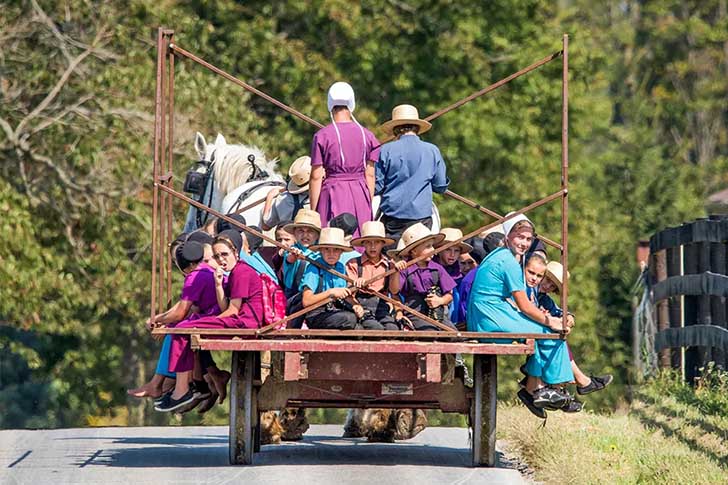
Forget expensive outings—these gatherings happen in homes or communal spaces, reducing costs and enhancing connections. This close-knit setup is efficient and helps save by relying on community support. It’s a model where everyone contributes, creating a lively social life without the hefty price tag of modern entertainment.
Secrets of Their Savings Success
Amish communities master the art of saving, reportedly tucking away up to 20% of their income through simple yet effective habits. Skipping debt and skipping luxuries is key, making every dollar go further. As Lorilee Craker shares in “Money Secrets of the Amish,” their financial philosophy is rooted in thrift and practicality.

By growing their food, sewing their clothes, and steering clear of credit cards, they avoid debt traps and keep their finances healthy. Amish lifestyle transforms ordinary purchases into smart, frugal choices. It inspires that saving doesn’t need high salaries or fancy strategies. Everything relies on consistency, avoiding splurges, and making the most of each penny.
Simple Jobs, Skilled Hands
Here, work-life fuses hands-on skills with community-centered trades. Farming is top, but many also branch into woodworking, construction, and crafting handmade furniture—skills that bring their craftsmanship to broader markets. Some venture into small businesses, selling produce or baked goods to the outside world. Meanwhile, some Amish work in construction outside their communities.
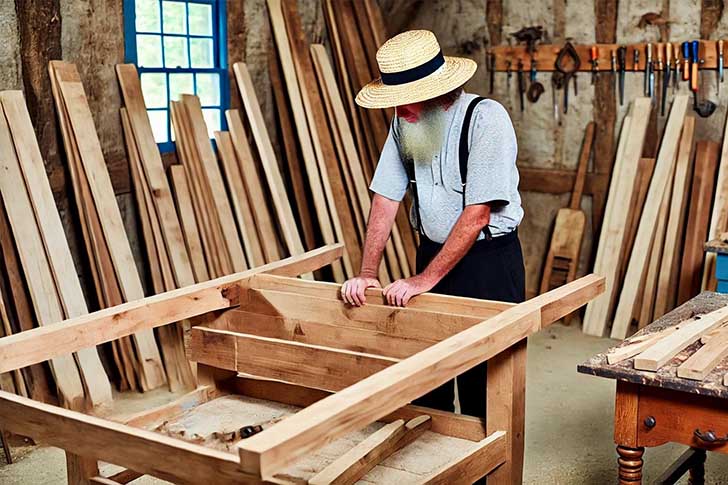
Their strong work ethic is highly valued in such fields. Skill acquired in practical trades naturally fosters a culture of saving, focusing on self-reliance over luxury. By emphasizing simple, productive jobs that avoid unnecessary costs, their approach offers a lesson in financial discipline. Well, meaningful work and sensible spending make a powerful combination.
Thriving with Humble Ventures
In their steady and modest way, Amish entrepreneurs have taken the small business world by storm. They embrace simplicity and honesty in business, creating a break from high-stakes competition. And studies show their ventures have a success rate of around 95%, outpacing the average in the outside world.
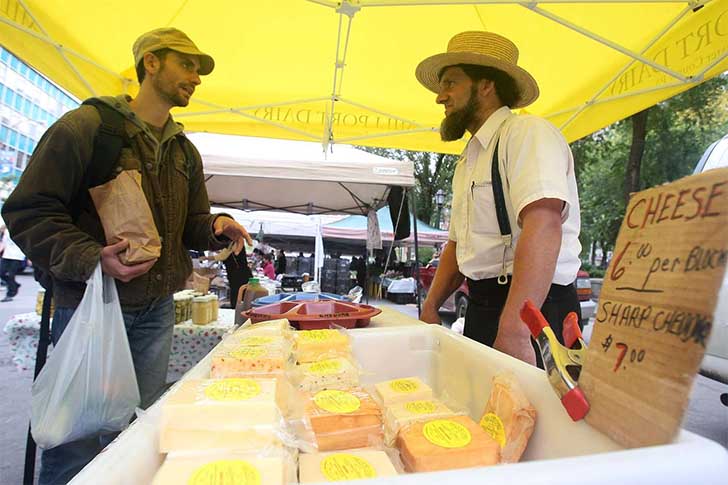
These businesses—often furniture shops, baked goods stores, or quilt-making ventures—benefit from a dedicated community, loyal customers, and a solid work ethic. When “English” employees join, they’re treated with fairness, learning dedication and quality values. Through this approach, their businesses thrive without flashy marketing, proving that sometimes straightforward hard work is the ultimate recipe for success.
Secret to Bulk Bargains
With families averaging seven to eight children, Amish households don’t dabble in single-item shopping. Bulk buying makes sense—flour, sugar, and oats are stocked up by the sack, ready for countless family meals. Buying in bulk lowers costs, minimizes trips to the store, and keeps pantry shelves well-prepped.

While staples come in bulk, smaller items like fabric or tools are bought retail, fitting specific needs without excess. This shopping style means less packaging waste and big savings over time, proving that stocking up is savvy. By avoiding constant smaller purchases trips, Amish families cut down on costs and time, showing how simplicity in shopping leads to savings.
Waste Not, Want Not
Thriftiness runs deep, and nothing goes to waste. Food close to expiration becomes creative recipes or is preserved for later—think soups, stews, or canned sauces. Bulk buying is a more organized system than a risk for waste; ingredients are rotated, ensuring everything gets used. Clothes don’t end up in the bin with a single tear or when outgrown.

Instead, outgrown items are handed down, while torn clothes are repurposed as quilts or cleaning rags. Every item finds a second purpose, whether in the kitchen or the closet. By maximizing each belonging’s life, they save money and resources, proving that creativity goes a long way in cutting costs.
Shopping Smart with Secondhand
A knack for thrift makes secondhand shopping a practical favorite. Clothes don’t need to be brand new—sturdy and functional do the trick, making thrift stores a fit. Their clothing style is simple and modest, with no trendy options and secondhand shops offer essentials without the frills. Selection may be limited, but durability and comfort top the list.
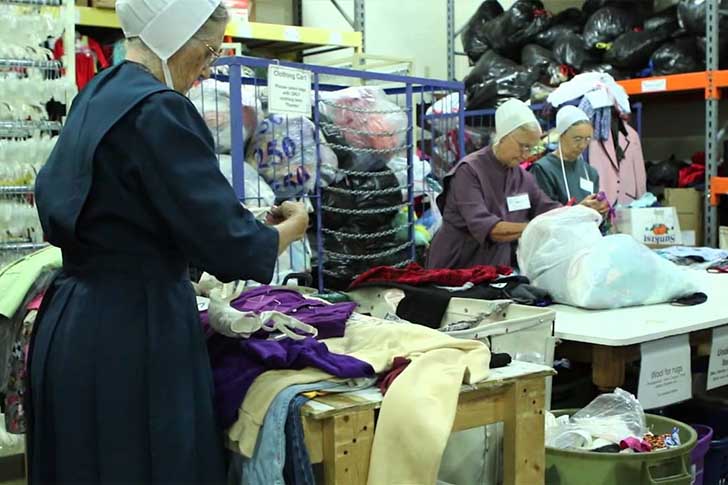
Buying secondhand saves money and stretches each dollar further, as gently used clothing comes at a fraction of the retail price. This approach allows families to keep costs low while maintaining their no-waste values. It’s a resourceful way to stock wardrobes and shows how reusing cuts costs without cutting quality.
Secrets to Green Eating
Farm-to-table is a lifestyle. Fresh produce from Amish gardens provides nutritious, chemical-free food, forming the backbone of their healthy eating habits. “Feinschmecker,” meaning “gourmet,” reflects their love for quality, fresh ingredients, turning simple dishes into wholesome meals. Author Lorilee highlights how this green approach boosts health and saves money.
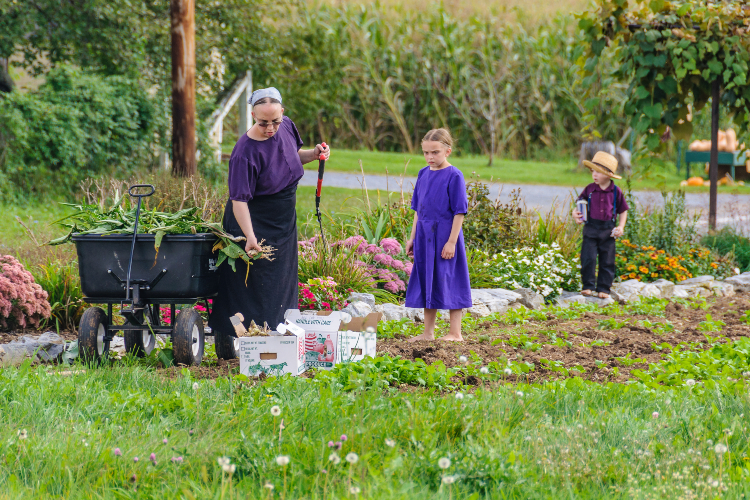
By growing their food, the Amish skip grocery costs while ensuring quality. From greens to homegrown veggies, every bite feels as rewarding as it is economical. This approach reduces expenses and adds satisfaction in knowing where their food comes from. It’s an inspiring lesson in both health and thrift, where freshness meets financial sense.
Memories Without the Photos
Relying on memory rather than snapshots, Amish communities cherish people in their minds instead of in pictures. Photographs are rarely allowed, and a strong “photographic memory” becomes essential, preserving the faces and moments of loved ones without a lens. Painted portraits are avoided and viewed as prideful, so memories are kept through stories and shared traditions.

Family gatherings are living tributes to those who’ve passed, weaving their presence into daily life. This approach proves cost-effective, skipping photography expenses or commissioned art. Focusing on memory and storytelling saves money and keeps loved ones close in a personal and timeless way. Indeed, some things don’t need a price tag.
Living Without the Screen
No smartphone bills here! Amish communities avoid mobile devices, dodging the endless cycle of upgrades and data plans. Technology is limited, with rare exceptions for business or emergencies, making their lifestyle budget-friendly. Lorilee observes that while the outside world spends on the latest gadgets, the Amish invest in family values and skills.

Instead of passing down iPhones or digital “heirlooms,” they prefer to leave a legacy of knowledge, land, and practical skills—things that can shape future generations. This low-tech approach keeps expenses down and emphasizes lasting connections over digital distractions. It’s a refreshing alternative to tech-driven inheritance, proving that sometimes less is more.

You must be logged in to post a comment Login